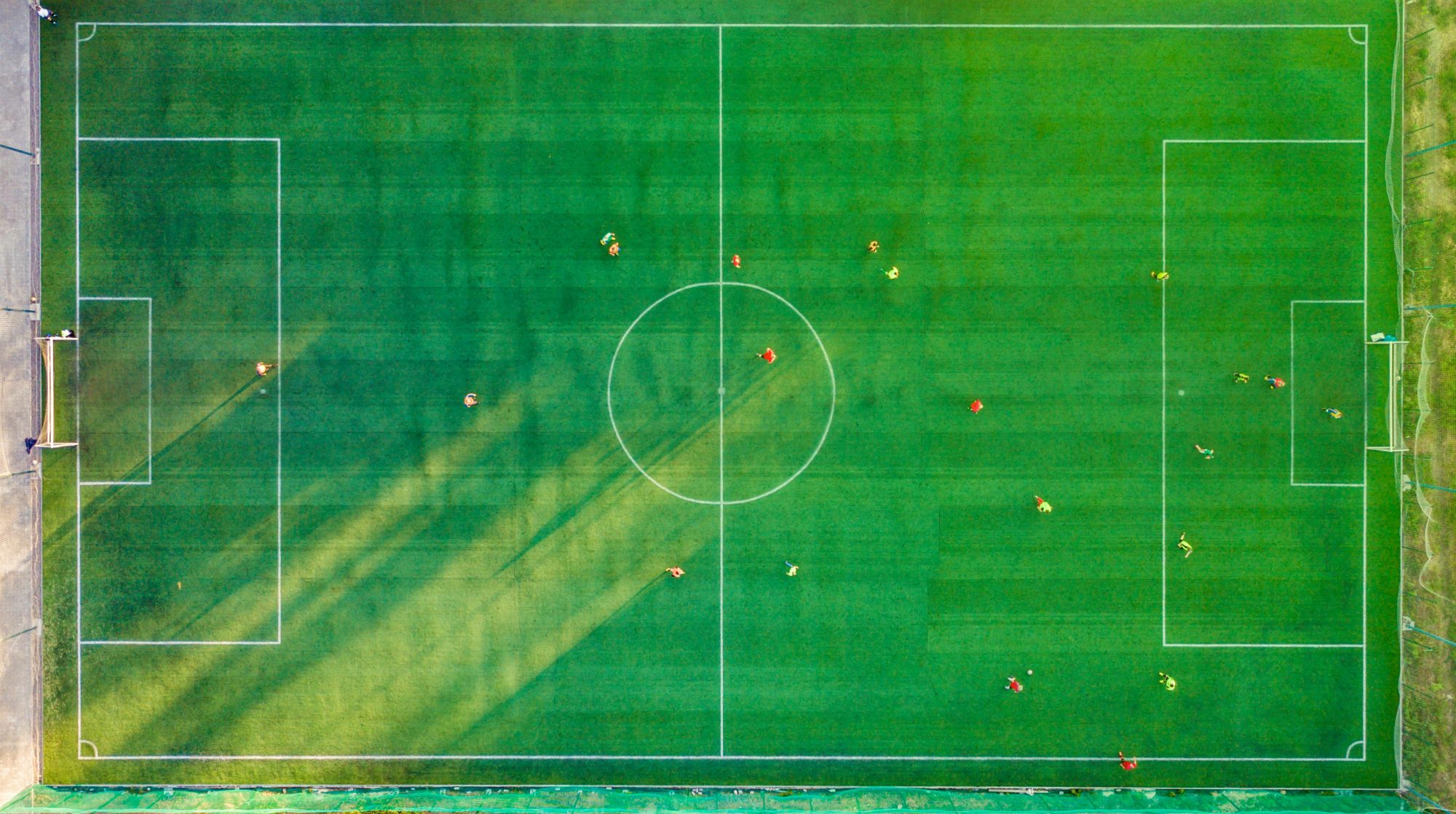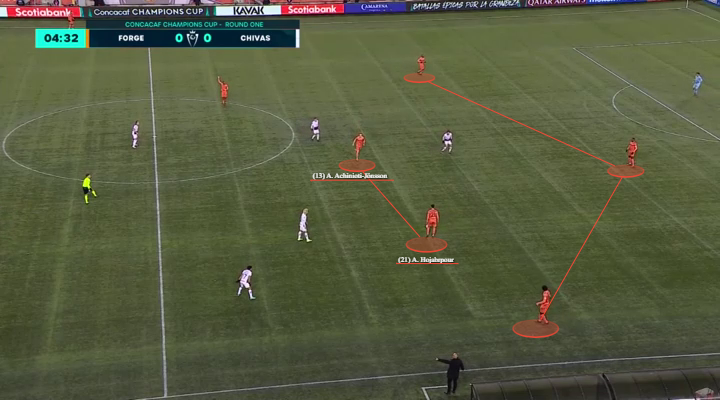Jesse Marsch is one of the most buzzworthy managers in the world of football at the moment. Since taking over at Red Bull Salzburg for Marco Rose, the American has developed a reputation as a tactical innovator and one of the most exciting young managers in the game. However, it’s not as though Salzburg’s record is anything out of the ordinary from previous managers. The buzz and attention surrounding the former MLS superstar is instead much more about how Marsch’s tactics and coaching styles have been out of the ordinary. His open communication regarding his coaching philosophies and principles of play has also been welcome, and only increased the manager’s growing reputation. One of the key principles guiding Salzburg forward is the team’s high pressing system. It’s always the first topic that Marsch discusses surrounding his team, as it can often be the emblem for the intense mentality the American deploys with his team. Here is a tactical analysis of how to press like Jessie Marsch’s Red Bull Salzburg.
pressing from the front
Embed from Getty ImagesIn a webinar I attended with The Coaches’ Voice, Jesse Marsch told us “Being more aggressive is always better than being more passive.” This high tempo, aggressive philosophy directly relates to just how much desire his team have to win the ball back. Unlike some teams that press from the front, Salzburg are actively trying to win the ball on both tackles and interceptions, not just in an attempt to force the opposition out of play or into a bad pass. Then when the team win the ball, they don’t want to keep it for prolonged periods of time. Instead they press vigorously and intensely to go “all in”, win the ball on a tackle and look to score. Marsch prides his team on this pressing mentality, particularly how intense he wants his team to sprint and how collective the approach becomes. The Austrian giants never press with just an individual sprinting their heart out to try and win the ball. It’s always a collective process. In fact, Marsch has even adopted something that he calls “Sal’s Theorem” based on something his New York Red Bulls player Sal Zizzo said to him about this togetherness. Marsch always allows his team to give their input and establish buy-in through talking about how they can improve together, and this is a great example. Essentially, Sal Zizzo said to Marsch that the difference between winning 3-0 and losing 3-0 could come down to the team pressing together, or not. So as soon as the first player pressures the ball, everyone else must go together at that exact moment. The data analysts at the club capture statistics such as number of sprints both in and out of possession, the speed of those sprints and the amount of time it took for players to react after the first player pressured the ball, to ensure these principles are being maintained in matches. This attention to detail holds the players accountable in maintaining this philosophy each and every game.
intensity + body positioning to force to the middle

Given the nature of what they look to do with their pressing (score goals), it’s very natural then that Salzburg attempt to force the opposition back toward their own goal. This is done through careful body positioning and angling, cutting off passing lanes in wide areas and forcing the opposition into central channels instead. This has obvious benefits for the verticality they wish to achieve in attack, and also implications for their ability to actually score goals from their pressure rather than just being ‘all talk and no action.’ Their press is also much more ball-oriented than man-oriented. This means that four to five players may surround a small section of the field at one time (where the ball is), even if there are fewer opposition players around the ball worth covering. As per the example image, Salzburg surround the opposition players like a pack of wolves, cutting off all wide and forward options, forcing them into a bad pass toward the middle of the field. A Salzburg striker is there to cut off the pass and kickstart the attack right away. You can also see in the example image how the team form not just one, but two diamonds to shut down the space. Diamonds are an excellent shape for pressing, as they work to mitigate every option a player may have in possession (forward, backward, left, and right). For greater context, the example was also taken from a match in which Die Roten Bullen were playing 4-2-2-2, as you can see both strikers coming to the side of the ball, and the left-back jumping up with the midfield line of pressure to cut off the wide option as the other members of the back-four slide across to create that balance in behind.
They may also opt for a 4-3-1-2 (4-4-2 Diamond) structure, in which a lone attacking midfielder is tasked with stopping the other team’s defensive midfielder from playing. Marsch has openly spoken about how in their first UEFA Champions League match against Liverpool in 2019, he changed the system from 4-2-2-2 to 4-3-1-2 when the team were down 2-0. One of the primary reasons for this change was the desire to stop Fabinho from playing out from the back and dictating the tempo of the game. Conveniently, it was Takumi Minamino who made the shift inside and then dominated the second half as Die Rotten Bullen clawed their way back to 3-3 (until a late Liverpool goal won it). The change in system didn’t stop the Reds from winning the match, but it was highly successful in mitigating Fabinho’s role in the build-up, whilst simultaneously adding another number in central areas who could drift in and out the forward line alongside Erling Haaland and Hee-Chan-Hwang to create greater goal-scoring opportunities in attack.
set-up on goal kicks

When setting up their pressing structure on opposition goal kicks, Salzburg make their 4-2-2-2 shape very narrow, actively preparing for the ball to travel to either side. By starting more towards the middle than to one side, each attacking midfielder and striker can have the chance at quickly getting over to the other side should it be required. The defensive midfielders are more likely to start in an even more compact position (closer together), working together to cut off second or third passes and mitigate options available in central channels for longer ones initially. The fullbacks hold more true to their position and stay wide, as only one of them will be involved in the initial press. Finally, the centre-backs communicate about the positioning of the opposition forwards and decide who is to keep a watchful eye if the opposition are playing with a lone striker. This may then change and shift as the ball goes across to one specific side. If the fullback is required to join the press higher up, the centre-back that started with the opposition striker may move over to cover the space or player vacated by the fullback. Communication is also key in establishing what side the ball is likely to be played to, so that the team can react as a unit as quickly as possible. By looking at the image, you can probably guess which side the opposition want to play to – the left, as they have positioned their attacking midfielder and striker to that side.
Then as the ball is played across to the left, immediately the team start sprinting toward that side as a collective unit. The only player in this image who has truly man oriented themselves is the right fullback, who can still shift across and ball-orient themselves if a switch of play were to be made to the other side. But unfortunately for the opposition, Salzburg have sprinted so quickly, with so much ferocity, that the opposition player has no choice but to give the ball away.

The striker and right attacking midfielder here work in tandem to shepherd the opposition player back toward their own goal as the first two involved in the press. The central midfielders have also moved up into advantageous positions, before the opposition midfielders even have time to react to their movement. They’re not just looking to cover space and opposition players around the ball, they’re also thinking about where they’ll be when their teammates inevitably win possession. You can also take notice of the left attacking midfielder, who is in a great position to get on the end of a cross should Salzburg win the ball. Conveniently, that’s exactly what happens. The Austrian giants win the ball, cross it in and score immediately.

This all happens within seconds of winning the ball, and the cross itself happens milliseconds after the right attacking midfielder makes the tackle. This means the opposition defenders have no time to react, as a wide open player is easily found and able to smash the ball into the back of the net. When Marsch says that he pressures the opposition not just to keep possession, but to score goals, he really means it. This is a classic example of exactly that. But more impressively, in both of the examples we’ve presented, you can also see the collective nature of the eleven players working together. The centre-backs for example have very specific roles to fulfill based on the movement of the ball and positioning of opposition players, even if they are never the ones doing any pressuring. They may still become important if the opposition are able to escape the press and thump a long ball forward. Their key task would then become about wining the ball in the air and stopping the opposition from gaining any momentum, before recycling play and helping their team restart the attack. Whenever Jesse Marsch speaks about his pressing approach, he always speaks about it as a collective process, and it is clear to see how they achieve that, and why it’s so important to their success.
counterpressing

The final topic of note when it comes to their pressing structure is what Jessie Marsch describes as “the net”. The net is typically used as a method of counter-pressing, by which all ten outfield players remain in close proximity to one another and form various triangular shapes surrounding the player on the ball. Fullbacks in the team also remain reserved rather than taking a gamble to rush forward or stretch the field. They stay behind the ball, covering opposition players who might become dangerous should the other team win possession. As will be highlighted in the next section, this means that they have greater ability to attack vertically, without ever needing to rely on switches of play or horizontal runs. The net has several attacking benefits, but the primary reason for its creation is more about counter-pressing, which basically means how the team set-up to thwart potential attacks when they are in possession of the ball. In other words, it’s what TheMastermindSite calls proactive defending, preparing for what might happen if things don’t go as planned. AC Milan for example rarely engage their central midfielders terribly high up the pitch, allowing for greater cover in central areas should their team lose the ball. Salzburg utilize this net structure by constantly remaining compact and moving together as a unit whenever they are in possession. This is more typical of the side when they are in longer spells with the ball, as in an ideal world they would look to attack at far greater speeds than would allow all ten players to catch up and create this net. This net therefore has benefits in allowing the team to combine in tight areas and play through an opposition team sitting deep in more of a mid to low block. Ideally, Salzburg are never in a position where they actually need to create this net and rely on counter-pressing, if everything is going well for their counter-attacking. So with that, if you are interested in hearing more about how Salzburg attack, be sure to check out our full Jessie Marsch – Tactical Analysis.
concluding thoughts
Embed from Getty ImagesRed Bull Salzburg are currently one of the most tactically intriguing sides in Europe, under the management of Jessie Marsch who is always open to sharing his methodologies with the public. Their tactical flexibility requires much in the way of footballing intelligence from the players, but it also means that they can continue to sell their stars without disrupting the harmony or their performances. Marsch’s team rely heavily on pressing, counter-pressing and quick attacking transitions upon winning the ball. This high intensity, high pressing mentality is continuously reinforced by Marsch and his coaching staff, even through data analytics to hold the players accountable. For all of his innovations and coaching expertise, Jessie Marsch may soon be on his way to a bigger club. But for now, Red Bull Salzburg are one of the most exciting sides to watch in Europe and can be proud of all that they’ve accomplished in such a short time with their American manager.
So there it is! A tactical analysis of how to press like Jessie Marsch’s Red Bull Salzburg. If you liked this article please consider donating to help TheMastermindSite.com grow and continue to develop quality articles like this. Also be sure to check us out on social media @mastermindsite and @DesmondRhys. Thanks for reading and see you soon!
You might also enjoy…
-> How To Coach Pressing
-> Pressing from the Front – Tactical Trends in 2020
-> Pressing From The Front – The Basics
-> Jesse Marsch – RB Salzburg – Tactical Analysis
Make a one-time donation
Make a monthly donation
Make a yearly donation
Choose an amount
Or enter a custom amount
Your contribution is appreciated.
Your contribution is appreciated.
Your contribution is appreciated.
DonateDonate monthlyDonate yearly







21 thoughts on “How To Press Like Jessie Marsch’s Salzburg”